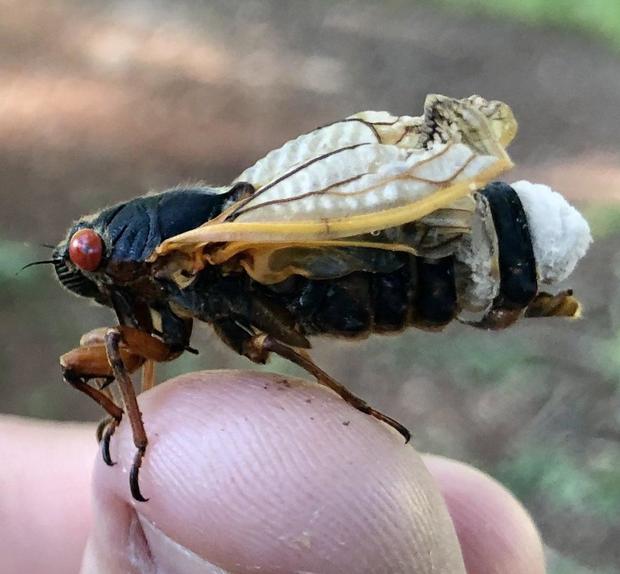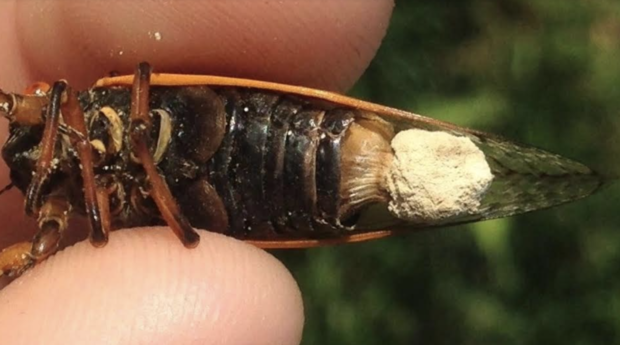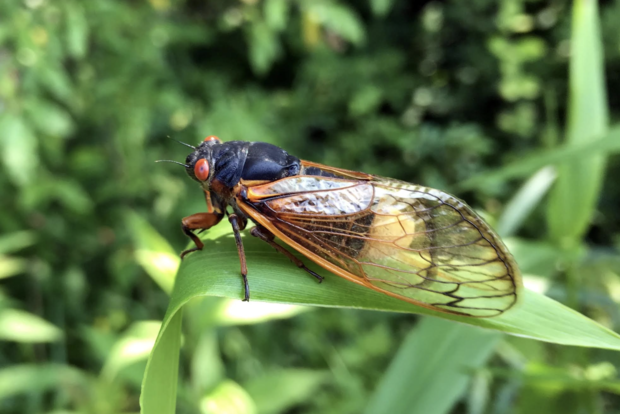CBS News
Hyper-sexual “zombie cicadas” that are infected with sexually transmitted fungus expected to emerge this year

Trillions of cicadas will emerge across several U.S. states this spring in an event one expert dubbed “cicada-geddon.” Not only are more cicadas than usual expected this year, but some of them will be “zombie cicadas” that are infected by a sexually transmitted fungus that makes them hyper-sexual.
Periodical cicadas spend most of their lives underground and only emerge after 13 or 17 years. This year, two broods of cicadas will emerge: Brood XIX, which comes out every 13 years, will emerge in the Georgia and Southeast, and Brood XIII, which emerges every 17 years, will appear in Illinois.
With this convergence, the bugs will arrive in numbers that have not been seen in generations.
Matthew Kasson, an associate professor of Mycology and Forest Pathology at West Virginia University, says both of these broods can be infected by a fungal pathogen called Massospora cicadina.
Once the cicadas emerge from the ground, they molt into adults, and within a week to 10 days, the fungus causes the backside of their abdomens open up. A chalky, white plug erupts out, taking over their bodies and making their genitals fall off.
Matthew Kasson
“The cicada continues to participate in normal activities, like it would if it was healthy,” Kasson told CBS News. “Like it tries to mate, it flies around, it walks on plants. Yet, a third of its body has been replaced by fungus. That’s really kind of bizarre.”
Kasson said the reason the cicadas might be able to ignore the fungus is that it produces an amphetamine, which could give them stamina.
“But there’s also something else unusual about it,” he said. “There’s this hyper-sexualized behavior. So, males for example, they’ll continue to try and mate with females — unsuccessfully, because again, their back end is a fungus. But they’ll also pretend to be females to get males to come to them. And that doubles the number of cicadas that an infected individual comes in contact with.”
Usually, male cicadas will let out a loud humming sound to attracted female cicadas and the female will flick her wings to signal she wants to mate. But the fungus has males flicking their wings like females to attract males and in turn, infect them, Kasson says.
Matthew Kasson
“In that way, the fungus is sexually transmissible. So, it spreads like an STD,” he said.
Kasson said where the fungus originates is still unclear. “A lot of this is still unclear because there’s a lot that happens below our feet,” he said.
Massospora cicadina produces spores on the cicadas and it is suspected that when the cicadas die, the spores get into the soil and infect other cicadas underground.
“In the month leading up to them emerging all together in a spectacular fashion, they’re waiting there, sub-surface, for the soil to reach 64 degrees,” Kasson said. It’s suspected the cicadas are infected when they are waiting underground, or when they are born and dig themselves into the soil, coming in contact with the fungus spores.
Fungus usually needs a host, like an insect, to carry the spores and spread the infection. Then, it kills the host.
Matthew Kasson
It’s suspected the Massospora cicadina fungus lays dormant for years and then begins to become a “puppet master” when the cicadas reach adulthood, Kasson said. “Because this is such a bizarre life cycle for an insect, the fungus has had to change its strategy. So, it basically keeps the host alive long enough to maximize dispersal,” he said.
It is unclear how the fungus would affect other wildlife or humans, but Kasson said in his research, he’s observed thousands of compounds in infected cicadas and some could be toxic.
“We know that a lot of animals are gobbling these cicadas up as they’re emerging — snakes and birds. Is it possible they’re having an effect on the animals that eat them? Yes, it is possible.” But, he said, less than 5% of cicadas are infected with the fungus and researchers have yet to observe any impact on other wildlife.
Kasson urges people not to eat the cicadas or kill them, but to take photos if they see the fugus on the bugs and share them with online science communities, like iNaturalist, to help researchers.
CBS News
Capturing Moriah Wilson’s Killer – CBS News

Watch CBS News
Be the first to know
Get browser notifications for breaking news, live events, and exclusive reporting.
CBS News
How to watch the Minnesota Vikings vs. Chicago Bears NFL game today: Livestream options, more

Getty Images
The Minnesota Vikings will take on the Chicago Bears today. The Vikings are currently 8-2, an impressive run so far this season, and will be looking to add a fourth win to their current streak after last Sunday’s 23-13 win against the Tennessee Titans. The Bears, on the other hand, are entering this game on the heels of a four-game losing streak after a tough 20-19 loss against the Green Bay Packers last Sunday.
Here’s how and when you can watch the Vikings vs. Bears game today, whether or not you have cable.
How and when to watch the Minnesota Vikings vs. Chicago Bears
The Vikings vs. Bears game will be played on Sunday, November 24, 2024 at 1:00 p.m. ET (11:00 a.m. PT). The game will air on Fox and stream on Fubo and the platforms featured below.
How and when to watch the Minnesota Vikings vs. Chicago Bears game without cable
You can watch this week’s NFL game on Fox via several streaming services. All you need is an internet connection and one of the top options outlined below.
Fubo offers you an easy, user-friendly way to watch NFL games on CBS, Fox, NBC, ABC, ESPN, and NFL Network, plus NCAA football channels. The Pro tier includes 200+ channels and unlimited DVR, while the Elite with Sports Plus tier adds NFL RedZone and 4K resolution. New subscribers get a seven-day free trial and all plans allow streaming on up to 10 screens simultaneously.
You can watch today’s game with a subscription to Sling’s Orange + Blue tier, which includes ESPN, ABC, NBC, and Fox. The plan offers 46 channels with local NFL games, nationally broadcast games and 50 hours of DVR storage. For complete NFL coverage, add Paramount+ to get CBS games, or upgrade with the Sports Extra add-on for additional sports channels like Golf Channel, NBA TV and NFL RedZone.
Watching NFL games, including Fox broadcasts, is simple with Hulu + Live TV, which includes 90 channels, unlimited DVR storage, and access to NFL preseason games, live regular season games and studio shows. The service includes ESPN+ and Disney+ in the subscription.
Want to watch today’s game live on your smartphone? If so, NFL+ streaming service is the solution you’re looking for. It lets you watch NFL Network and out-of-market games on mobile devices, with an upgrade option to NFL+ Premium that includes NFL RedZone for watching up to eight games simultaneously. Note that NFL+ only works on phones and tablets, not TVs.
CBS News
How to watch the Detroit Lions vs. Indianapolis Colts NFL game today: Livestream options, more

Nic Antaya/Getty Images
The Detroit Lions will face off against the Indianapolis Colts today. The Lions enter this game as top contenders with a near-perfect record of 9-1 so far this season. The Colts, who are 5-6 this season, could have a tough game on their hands against the Lions but will be looking to rack up another win after prevailing over the New York Jets in a tight game last Sunday.
Here’s how and when you can watch the Colts vs. Lions game today, whether or not you have cable.
Here’s how and when to watch the Detroit Lions vs. Indianapolis Colts
The Lions vs. Colts game will be played on Sunday, November 24, 2024 at 1:00 p.m. ET (11:00 a.m. PT). The game will air on Fox and stream on Fubo and the platforms featured below.
How and when to watch the Detroit Lions vs. Indianapolis Colts game without cable
You can watch this week’s NFL game on Fox via several streaming services. All you need is an internet connection and one of the top options outlined below.
Experience NFL action like never before with Fubo’s comprehensive sports streaming platform. From Sunday showdowns to primetime matchups, catch every NFL game across major networks including CBS, Fox, NBC, ABC, ESPN and NFL Network. Choose the Pro package to unlock 200+ channels and limitless DVR storage, or elevate your game-day experience with the Elite with Sports Plus package, featuring NFL RedZone’s commercial-free scoring highlights and stunning 4K quality.
Test drive the service with a no-commitment seven-day free trial, and share the excitement with family and friends — Fubo supports simultaneous streaming on up to 10 devices, so everyone can watch their favorite teams.
You can watch today’s game with a subscription to Sling’s Orange + Blue tier, which includes ESPN, ABC, NBC, and Fox. The plan offers 46 channels with local NFL games, nationally broadcast games, and 50 hours of DVR storage. For complete NFL coverage, add Paramount+ to get CBS games, or upgrade with the Sports Extra add-on for additional sports channels like Golf Channel, NBA TV and NFL RedZone.
Watching NFL games, including Fox broadcasts, is simple with Hulu + Live TV, which includes 90 channels, unlimited DVR storage, and access to NFL preseason games, live regular season games and studio shows. The service includes ESPN+ and Disney+ in the subscription.
Want to watch today’s game live on your smartphone? If so, NFL+ streaming service is the solution you’re looking for. It lets you watch NFL Network and out-of-market games on mobile devices, with an upgrade option to NFL+ Premium that includes NFL RedZone for watching up to eight games simultaneously. Note that NFL+ only works on phones and tablets, not TVs.













